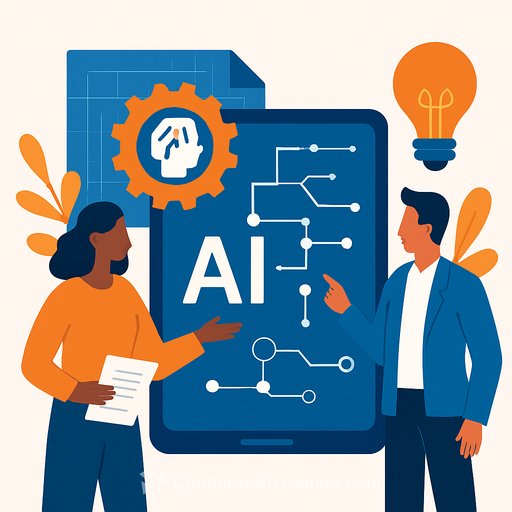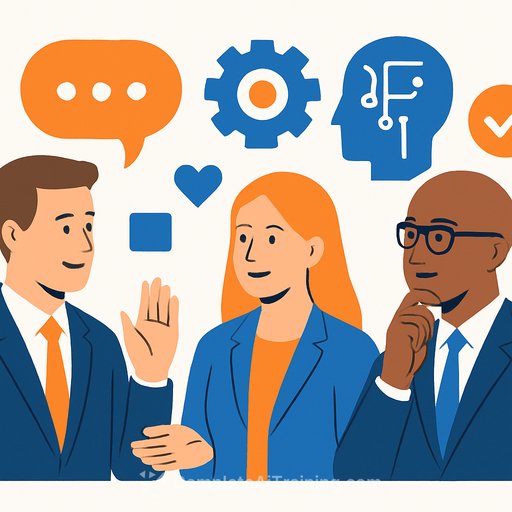Breaking Down Silos: Why HR and IT Must Unite on AI Strategy
AI is changing how work gets done, but it also creates gaps when teams operate in isolation. HR is responsible for people, fairness, and compliance. IT is responsible for systems, data, and security. If these functions aren't aligned from day one, AI efforts stall or spark risk.
The core issue is simple: AI decisions affect people, and AI design choices create legal exposure. You need both disciplines at the same table, building one plan, with shared accountability.
The Trust Gap
"The biggest hurdle in AI adoption isn't the technology, but the trust gap. For IT, the goal is to be a strategic partner to HR from the very beginning, ensuring any AI tool is built on a foundation of secure, reliable data. When we break down those silos to build that trust, that's when real innovation can happen," says Maria Lees, Senior Director of Enterprise IT at G-P.
Trust is not a slogan. It's architecture, documentation, and explainability that HR can defend with employees, regulators, and leadership.
Why Siloed AI Creates Risk
When HR can't see how an AI system is built, they can't assess bias, fairness, or compliance. When IT doesn't see HR workflows and regulations, they optimize for accuracy and speed while missing legal and cultural risks. The result: tools people don't trust and programs legal can't approve.
AI governance failures don't stay contained. They cascade into hiring disputes, reputational damage, and stalled adoption across the business.
Global Compliance Pressure on HR
Regulation is moving fast and varies by region and sector. The EU AI Act sets obligations for high-risk systems used in hiring, promotion, and performance management. California's privacy regulator is advancing rules on automated decisionmaking that will require transparency and opt-out controls.
Multinationals face GDPR in the EU, state-level rules in the U.S., and new frameworks in APAC. Compliance isn't just about outcomes; it scrutinizes process: training data, features, model design, and monitoring. That demands technical fluency HR teams often don't have-yet.
There's also the ongoing burden: model drift can turn a compliant system into a non-compliant one over time. Documentation, testing, and monitoring must be continuous, not one-and-done.
What IT Must Do to Earn HR's Confidence
Technical choices shape HR risk. Optimizing for accuracy without explainability puts HR on the defensive. Data pipelines built without clear provenance and access controls erode trust even before launch.
- Make data governance visible: Share data sources, collection methods, retention rules, and access controls in plain language.
- Prioritize interpretability: Use models and techniques that support explanations HR can deliver to employees and legal.
- Build auditability in: Provide dashboards that show inputs, decision paths, fairness metrics, and version history.
- Design for consent and contestability: Enable opt-outs where required and clear escalation paths for human review.
Collaborate Early-or Pay Later
Involve HR at the idea stage, not after vendor selection. Co-create requirements that account for both technical feasibility and human impact. Joint discovery reduces rework, resistance, and compliance issues.
Adopt an "empathetic" approach: bake transparency, fairness, and accountability into every phase-from problem definition to deployment and measurement.
Shared Controls HR and IT Should Own Together
- Use cases and risk ratings: Classify each AI use (e.g., screening, performance, L&D) and assign controls based on risk.
- Data minimization and provenance: Document what data is used, why, and where it came from. Eliminate unnecessary signals.
- Model cards and decision logs: Keep living documentation on training data, features, known limits, and release notes.
- Bias and performance testing: Test by cohort (gender, ethnicity, age, disability) and by geography. Set thresholds and remediation steps.
- Human-in-the-loop: Define when a person must review, override, or provide feedback on AI outputs.
- Employee communication: Create concise notices that explain what the AI does, why it's used, and how to challenge outcomes.
- Monitoring and drift alerts: Track fairness, accuracy, and stability over time; trigger reviews on threshold breaches.
Emerging Hybrid Roles
Expect new roles that blend HR, legal, and data science-AI HR Business Partners, People Data Product Managers, and AI Governance Leads. These roles turn policy into practice and keep both teams aligned as systems evolve.
A Practical 90-Day Adoption Plan
- Days 0-30: Form an HR-IT-Legal council. Inventory current and planned AI use cases. Classify risk. Agree on documentation standards and model selection guidelines.
- Days 31-60: Run a pilot on one high-impact HR workflow (e.g., candidate screening or internal mobility). Implement model cards, fairness tests, user training, and a contestability process.
- Days 61-90: Review pilot outcomes with employees and managers. Adjust thresholds, prompts, and data inputs. Publish governance artifacts. Plan phased rollout with ongoing monitoring.
Feedback Loops That Keep Systems Honest
HR sees human impact first-appeals, sentiment, adoption blockers. IT sees system behavior-latency, drift, data gaps. Combine both signals in monthly reviews to tune models and policy.
This closed loop is how you sustain compliance, trust, and business value long term.
The Upside for HR
"What's exciting is that leveraging AI can allow HR professionals to be more human. We're finally able to step out of the admin weeds and focus on strategy, coaching, and culture. When IT gives us a solid, secure foundation, we can confidently use AI to build better, fairer, and more meaningful work experiences for everyone," says Connie Diaz, Senior Director of HR at G-P.
The message: make AI boring on the backend so HR can be brilliant on the front end.
Where to Build Skills Next
If your HR team needs practical training on AI use cases, prompts, and governance workflows by job function, explore this curated catalog: AI courses by job.
Your membership also unlocks:






